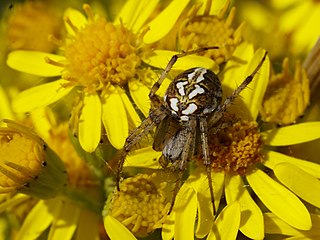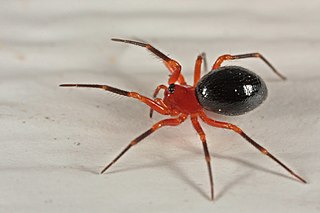
Linyphiidae is a family of very small spiders comprising 4694 described species in 623 genera worldwide. This makes Linyphiidae the second largest family of spiders after the Salticidae. The family is poorly known; new genera and species are still being discovered throughout the world. The newest such genus is Himalafurca from Nepal, formally described in April 2021 by Tanasevitch. Because of the difficulty in identifying such tiny spiders, there are regular changes in taxonomy as species are combined or divided.

Scaffold web spiders (Nesticidae) is a family of araneomorph spiders closely allied with tangle web spiders. Like the "Theridiidae", these spiders have a comb of serrated bristles on the hind tarsi that are used to pull silk bands from the spinnerets. It contains 16 genera and about 300 species, many of which are associated with caves or overhangs. The genus Nesticus is the type for the family and is found throughout the world. The related Eidmannella has speciated considerably in Texas caves and includes some extremely localized species that are considered threatened. One species, Eidmannella pallida, is found in caves and under overhangs, but also in agricultural fields and other habitats away from such restricted areas. The genus Carpathonesticus is found in central Eurasia.

Pimoidae is a small family of araneomorph spiders first described by J. Wunderlich in 1986. It contains 37 species in four genera and is monophyletic. It is closely related to the Linyphiidae, and is sometimes treated as synonymous with that family.

Neoscona, known as spotted orb-weavers and barn spiders, is a genus of orb-weaver spiders (Araneidae) first described by Eugène Simon in 1895 to separate these from other araneids in the now obsolete genus Epeira. The name Neoscona was derived from the Greek νέω, meaning "spin", and σχοῐνος, meaning "reed" They have a mostly pantropical distribution and one species, Neoscona adianta, has a palearctic distribution. As of April 2019 there are eight species that can be found in the United States and Canada:

Macrothele is a genus of mygalomorph spiders in the family Macrothelidae, and was first described by A. Ausserer in 1871. It is the only genus in the family Macrothelidae, and most species occur in Asia, from India to Japan, and Java, with four found in Africa, and two in Europe. The name is derived from Ancient Greek μακρός ("makro-"), meaning "big", and θηλή ("thele"), referring to the spinnerets.

Hylyphantes is a genus of dwarf spiders that was first described by Eugène Louis Simon in 1884. It is distinct from related genera by a pair of spiral copulatory ducts in the female, which are matched by a turbinated embolus in the male. Both sexes are similar in appearance; the male has no modifications.

Savignia is a genus of sheet weavers that was first described by John Blackwall in 1833. The name honors the French naturalist Marie Jules César Savigny.
Tibioploides is a genus of sheet weavers that was first described by K. Y. Eskov & Y. M. Marusik in 1991.
Arcuphantes is a genus of dwarf spiders that was first described by Ralph Vary Chamberlin & Vaine Wilton Ivie in 1943.

Dicymbium is a genus of dwarf spiders that was first described by Anton Menge in 1868.
Fusciphantes is a genus of Asian dwarf spiders that was first described by R. Oi in 1960.

Gongylidioides is a genus of Asian dwarf spiders that was first described by R. Oi in 1960.

Hypselistes is a genus of dwarf spiders that was first described by Eugène Louis Simon in 1894.
Nipponotusukuru is a genus of Asian dwarf spiders that was first described by H. Saito & H. Ono in 2001.

Oilinyphia is a genus of Asian dwarf spiders that was first described by H. Ono & H. Saito in 1989.
Ryojius is a genus of Asian sheet weaver spiders that was first described by H. Saito & H. Ono in 2001. As of May 2019 it contains only three species, found in China, Japan, and Korea: R. japonicus, R. nanyuensis, and R. occidentalis.

Saaristoa is a genus of sheet weavers that was first described by Alfred Frank Millidge in 1978.
Saitonia is a genus of Asian sheet weavers that was first described by K. Y. Eskov in 1992.
Strandella is a genus of Asian sheet weavers that was first described by R. Oi in 1960.
Tojinium is a monotypic genus of Japanese sheet weavers containing the single species, Tojinium japonicum. It was first described by H. Saito & H. Ono in 2001, and is only found in Japan.











